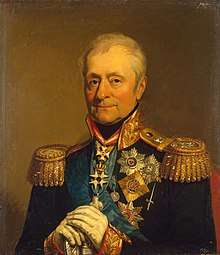Levin August von Bennigsen
Levin August Gottlieb Theophil Graf[1] von Bennigsen (Russian: Ле́вин А́вгуст Го́тлиб Теофи́ль фон Бе́ннигсен, romanized: Lévin Ávgust Gótlib Teofíl' fon Bénnigsen, also Лео́нтий Лео́нтьевич Бе́ннигсен (Leóntii Leónt'yevich); 10 February 1745 – 3 December 1826) was a German general in the service of the Russian Empire.[lower-alpha 1]
Levin August von Bennigsen | |
|---|---|
 Portrait by George Dawe | |
| Native name | Russian: Лео́нтий Лео́нтьевич Бе́ннигсен |
| Born | 10 February 1745 Braunschweig, Electorate of Hanover, Holy Roman Empire |
| Died | 3 December 1826 (aged 81) Banteln, Kingdom of Hanover, German Confederation |
| Battles/wars | |
| Awards | Order of St. Andrew |
Biography
Bennigsen was born on 10 February 1745 into a Hanoverian noble family in Braunschweig (English toponym: Brunswick).[2] His family owned several estates at Banteln in Hanover.[2] Bennigsen served successively as a page at the Hanoverian court and as an officer of foot-guards,[3] and four years later, in 1763, as captain, he participated in the final campaign of the Seven Years' War.[2] In 1764, after the death of his father and his marriage to Baroness Steimberg, he retired from the Hanoverian army, and settled at the estates he owned in Banteln.[2] In 1773, shortly after reentering Hanoverian service for a brief period, he entered the Russian service as a field officer, and was subsequently accepted into the Vyatka musketeer regiment in the same year.[2][3] He fought against the Turks in 1774 and in 1778, becoming lieutenant-colonel in the latter year. In 1787 his conduct at the storming of Ochakov won him promotion to the rank of brigadier, and he distinguished himself repeatedly in smashing the Kościuszko Uprising and in the Persian War of 1796 where he fought at Derbent.[3][2] On 9 July 1794, he was promoted to Major General for his accomplishments in the former campaign, and on 26 September 1794 he was awarded the Order of St. George of the Third Degree and an estate in Minsk guberniya.[2]
In 1798 Bennigsen was fired from military service by the Tsar Paul I allegedly because of his connections with Platon Zubov. It is known that he took an active part in the planning phase of the conspiracy to assassinate Paul I, but his role in the actual killing remains a matter of conjecture. Tsar Alexander I made him governor-general of Lithuania in 1801, and in 1802 a general of cavalry.[3]
In 1806 Bennigsen was in command of one of the Russian armies operating against Napoleon, when he fought the Battle of Pultusk and met the emperor in person in the bloody battle of Eylau (8 February 1807).[3] In the Battle of Pultusk he resisted French troops under Jean Lannes before retreating. This brought him the Order of St. George of the Second Degree while after the battle of Eylau he was awarded Order of St. Andrew - the highest order in the Russian empire. Here he could claim to have inflicted the first reverse suffered by Napoleon, but six months later Bennigsen met with the crushing defeat of Friedland (14 June 1807) the direct consequence of which was the treaty of Tilsit.[3]
Bennigsen was heavily criticised for the Battle of Friedland and for the decline of discipline in the army and now retired for some years, but in the campaign of 1812 he reappeared in the army in various responsible positions. He was present at Borodino, and defeated Murat in the engagement of Tarutino[3] where he himself was wounded in the leg, but on account of a quarrel with Marshal Kutuzov, the Russian commander-in-chief, he was compelled to retire from active military employment.[3]
.jpg)
After the death of Kutuzov, Bennigsen was recalled and placed at the head of an army.[3] Bennigsen participated in the battles of Bautzen and Lützen, leading one of the columns that made the decisive attack on the last day of the Battle of Leipzig (16–19 October 1813). On the same evening he was made a count by the emperor Alexander I, and he afterwards commanded the forces which operated against Marshal Davout in North Germany,[3] most notably in the year-long Siege of Hamburg (1813–14). After the Treaty of Fontainebleau he was awarded the St. George order of the First Degree - the highest Russian military order - for his actions in the Napoleonic wars in general.
After the general peace Bennigsen held a command from 1815 to 1818, when he retired from active service and settled on his Hanoverian estate of Banteln near Hildesheim.[3] By the end of his life he completely lost his sight. He died on 31 December 1826, in Banteln, eight years after he had retired.[2] His son, Count Alexander Levin von Bennigsen (1809-1893) was a distinguished Hanoverian statesman.[3]
Bennigsen wrote the three-volume "Mémoires du général Bennigsen", which was published in Paris in 1907-1908.[2] Though they contain "fascinating" details regarding the Russian wars and battles between 1806-1813, the work often beautifies historical facts.[2]
Notes
- Russian: Лео́нтий Лео́нтьевич Бе́ннигсен, Leontiy Leontyevich Bennigsen
- Regarding personal names: Until 1919, Graf was a title, translated as Count, not a first or middle name. The female form is Gräfin. In Germany since 1919, it forms part of family names.
- Mikaberidze 2005, p. 34.
- Chisholm 1911, p. 742.
References

Sources
- Mikaberidze, Alexander (2005). Russian Officer Corps of the Revolutionary and Napoleonic Wars. Casemate Publishers. ISBN 978-1611210026.CS1 maint: ref=harv (link)